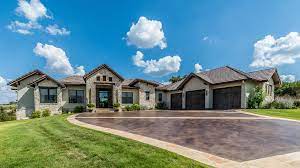Unleashing the Beauty of Decorative Concrete: Transforming Your Space with Style

Creativity knows no bounds when it comes to designing and renovating interior and exterior spaces. In recent years, decorative concrete has transformed the design and construction industries. Today’s decorative concrete provides an abundance of design options that can transform any space into a breathtaking work of art.
This blog will discuss the aesthetics of decorative concrete, its various applications, and how it can be used to unleash style and elegance in residential and commercial spaces.
The Concrete Renaissance: From Plain to Decorative
Due to its durability and adaptability, concrete has been employed as a building material for centuries. However, until relatively recently, its potential as a design element was not fully realized. Traditional concrete served as a foundation and structural material, but its aesthetic appeal was often lacking.
In the middle of the 20th century, decorative concrete began to gain popularity. Innovations in concrete mixtures, coloring methods, and stamping technology have expanded the scope of possible outcomes. Concrete was no longer limited to a simple gray hue; it could imitate the appearance of natural stones, bricks, pavers, and even wood.
The Uses of Decorative Concrete
The beauty of decorative concrete lies in its adaptability to various indoor and outdoor applications. Let’s examine some common applications of decorative concrete:
1. Patios of Stamped Concrete
Patios made of stamped concrete are a popular option for homeowners seeking to improve their outdoor living spaces. Using specialized stamps, concrete contractors can create patterns resembling natural stones, bricks, or tiles. Stamped concrete patios combine the durability of concrete with the aesthetics of other materials, making them an economical and aesthetically pleasing option.
2. Ornamental Concrete Driveways
No longer are driveways comprised of simple, gray slabs. Driveways made of decorative concrete allow homeowners to express their creativity and enhance their curb appeal. With imprinted patterns, colored concrete, and unique designs, driveways can become aesthetically pleasing elements that complement the home’s architecture.
3. Concrete Floors Stained
Stained concrete floors are growing in popularity indoors. Existing concrete surfaces can be stained with acid- or water-based stains to create a marbled effect with a variety of colors and tones. Traditional flooring materials are replaced by a seamless and low-maintenance alternative: stained concrete floors.
4. Decorative Concrete Swimming Pool Decks
The aesthetic appeal and slip-resistant properties of decorative concrete can greatly benefit pool decks. With decorative overlays, homeowners can create unique patterns and textures around their pools, enhancing the aesthetic and practical value of the space.
5. Decorative Concrete Kitchen Countertops
Due to their unique appearance and adaptability, decorative concrete countertops have gained popularity in kitchen and bathroom design. Concrete can be molded into a variety of shapes and thicknesses, allowing for customized designs that complement the space’s overall aesthetic.
6. Vertical Concrete Applications
In addition to horizontal surfaces, decorative concrete can also be applied vertically to walls and other vertical surfaces. Using molds and specialized equipment, concrete contractors can create textured walls, accent walls, and other architectural elements that add depth and personality to a space.
The Art of Stamping Concrete
The art of concrete stamping lies at the center of many decorative concrete applications. The technique of stamping involves pressing specialized stamps into freshly poured concrete to create patterns and textures that resemble those of natural materials. Voici how the procedure works:
1. Surface Preparation
The initial step of the stamping process is to prepare the concrete surface by cleaning and leveling it, and removing any debris.
2. Utilization of the Release Agent
The surface is treated with a release agent to prevent the stamps from adhering to the concrete. Additionally, the release agent imparts color and depth to the surface, thereby enhancing its overall appearance.
3. Applying Stamps
The stamps are carefully placed in a predetermined pattern on the surface of the concrete. These stamps may be made of rubber, polyurethane, or other materials designed to withstand stamping pressure.
4. Impression of Concrete
The concrete is stamped using a combination of manual and mechanical pressure once the stamps are in place. This method imprints the design and texture into the surface.
5. Coloring And Coating
After stamping the concrete, additional coloring or staining can be applied to enhance the appearance of the final surface. Sealing the concrete protects it from stains, ultraviolet rays, and other potential damage.
The Advantages Of Decorative Concrete
Numerous advantages make decorative concrete an attractive option for architects, homeowners, and businesses:
1. Appealing Appearance
Aesthetic appeal is one of the most significant benefits of decorative concrete. It offers the appearance of more expensive materials, such as natural stone or pavers, for a fraction of the price.
2. Customization Choices
Concrete decorative offers limitless design possibilities. From imprinted patterns and textures to custom colors and finishes, concrete can be customized to fit any design concept.
3. Resilience and Prolonged Life
Similar to conventional concrete, decorative concrete is durable and resilient. It can withstand heavy foot traffic, weather fluctuations, and other environmental factors when properly installed and maintained.
4. Cost Efficiency
Decorative concrete is an economical alternative to more expensive building materials. It enables homeowners and businesses to attain an upscale appearance without breaking the bank.
5. Minimum Maintenance
Decorative concrete Greenville requires less maintenance than materials such as natural stone and wood. Typically, regular cleaning and occasional resealing are sufficient to preserve its beauty for many years.
Unleash Your Personality with Decorative Concrete
The versatility of decorative concrete permits its use in a wide range of design styles, from contemporary to rustic and beyond. Here are some interior design ideas for incorporating decorative concrete:
1. Modern Minimalism
In modern design, simplicity and clean lines take center stage. This aesthetic is flawlessly complemented by decorative concrete with a sleek, polished finish. Geometric patterns imprinted on stamped concrete can also add a touch of interest without overwhelming the space.
2. Rustic Appeal
Consider using stamped concrete that resembles natural stone or aged wood for a rustic or farmhouse aesthetic. This creates an inviting atmosphere that complements rustic furniture and decor.
3. Mediterranean Elegance
Choose stamped concrete with intricate tile patterns to evoke the allure of a Mediterranean villa. Colored concrete in earthy hues, such as terracotta or sandy beige, can contribute to a Mediterranean atmosphere.
4. Industrial Style
Industrial-style interiors feature utilitarian and raw materials. Gray or charcoal stained concrete floors, combined with exposed brick and metal accents, create a chic industrial aesthetic.
5. Retreat Inspired by Nature
You can also use decorative concrete to bring the beauty of nature indoors. In spaces such as sunrooms and enclosed patios, stamped concrete with leaf or floral patterns can produce a natural and calming atmosphere.
Conclusion
Decorative concrete has revolutionized the world of design and construction by demonstrating that concrete is not merely a utilitarian building material, but also a canvas for artistic expression. Whether indoors or outdoors, decorative concrete provides an abundance of design options that can transform any space into a stylish and inviting oasis.
From stamped concrete patios and driveways to stained concrete floors and countertops, decorative concrete offers virtually limitless design options. Embrace the aesthetic value of decorative concrete and maximize its capacity to enhance the style and elegance of your residential and commercial spaces. Your space can be transformed into a modern design masterpiece with the assistance of skilled concrete contractors and a dash of creativity, showcasing the versatility and beauty of decorative concrete, find more here.






